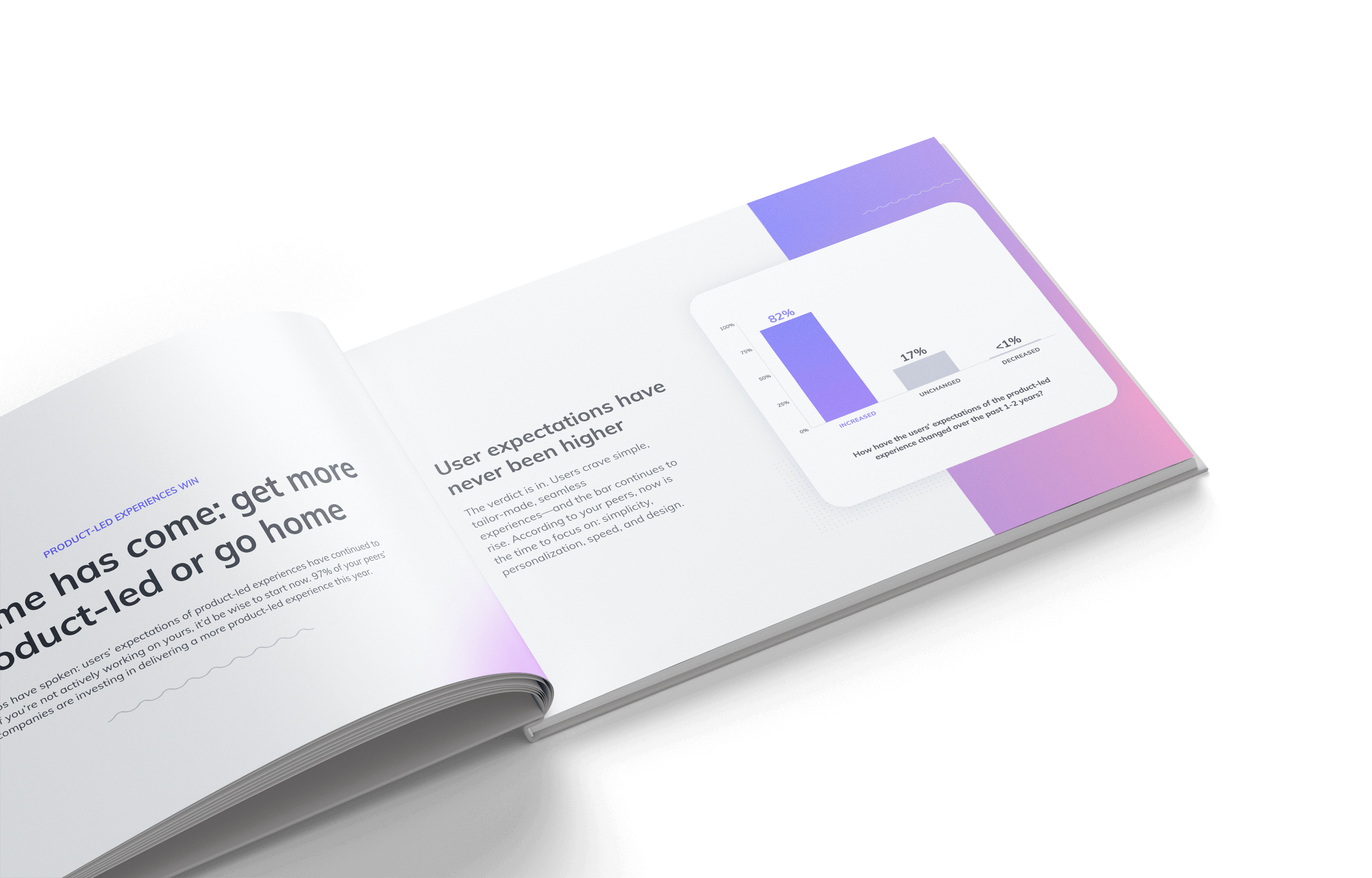2023 Product-Led Experience Report
Scaling a SaaS business has never been harder. Markets are fiercely competitive and real product differentiation is increasingly rare. Now, the product that’s easier to try, buy, and get value from is the product that wins—but that’s easier said than done. We asked 350 SaaS professionals how their organizations are adapting, what’s working for them, and what to watch out for in the pursuit of a more product-led experience.

About the report
Welcome to Appcues’ 2023 Product-Led Experience Report. We’re glad you’re here!
Today’s differentiation—the edge owned by top growing SaaS companies—is experience. This report was designed to help you figure out what that means to your business and what to do about it.
All data and perspectives included in the 2023 Product-Led Experience Report are based on 350+ survey responses gathered by Appcues between December 2022 and March 2023.













The time has come: get more product-led or go home
SaaS pros have spoken: users’ expectations of product-led experiences have continued to surge. If you’re not actively working on yours, it’d be wise to start now. 97% of your peers’ companies are investing in delivering a more product-led experience this year.
User expectations have never been higher
The verdict is in. Users crave simple, tailor-made, seamless experiences—and the bar continues to rise. According to your peers, now is the time to focus on: simplicity, personalization, speed, and design.
82% of survey respondents believe that users’ expectations have increased over the past 1-2 years. This shouldn’t surprise anybody in a competitive category. Your current and prospective customers have more options than ever before.

“
People are harder to impress. There are so many products out there that the value has fallen in the buyer’s eyes. How do you engage people more quickly and effectively so you can reduce CAC? You have to lower the energy required to get a reaction out of a prospective customer.

Patrick Campbell


Product-led experiences are a competitive edge
To win in a wildly crowded market, you’ve got to give users what they want—more product-led experiences. 88% of your peers believe that delivering a product-led experience is important to differentiating and remaining competitive.
The harsh reality is that many product categories are quickly becoming commoditized. Buyers are struggling to parse through the noise, so they gravitate toward solutions that make things easy. Again: it’s about simplicity, personalization, speed, and design.
The train is leaving the station…
The upside is obvious and the plans are in motion. 97% of all survey respondents are investing in delivering a more product-led experience in 2023. They expect to see: improved retention rates, customer satisfaction, win rates, and revenue growth. All aboard!

Product-led growth is a team sport
The single biggest takeaway from this year’s survey: delivering a great product-led experience requires teamwork and cross-functional collaboration. Every team has a stake and value to contribute. Your job: make sure they have the tools and resources to do it.
“
Truly great product-led experiences emerge from empowered, fully cross-functional teams. Instead of centering PMs in every decision, actual product-led growth requires a collaborative, team effort, where every function supports each other to deliver a seamless customer experience.

Ramli John
Content Director


Every function has a stake in user engagement
The data says it all: while product teams are most likely to foot the bill for user messaging and engagement tools, nearly 50% of respondents said they’re paid for by marketing, customer success, or “multiple teams.”
Regardless of which team pays, every team contributes. We asked which departments contribute to messaging and engaging with users, and the answer can be summed up as “pretty much all of them.” Check out those numbers!

Strong collaboration is the key to success
With so many stakeholders involved, collaboration is top of mind for many. Strong collaboration is critical to ensuring user engagement is consistent and effective and, when done right, can create rapid feedback and iteration cycles that accelerate progress.
When asked how they currently collaborate, survey respondents noted the importance of messaging and design reviews, aligning on goals, and over-communication—with an emphasis on transparency and a willingness to share knowledge and expertise.


The right technology makes collaboration easier
While teams typically rely on recurring cross-functional meetings to keep everyone on the same page, technology also plays a significant role.
Survey responses surfaced three primary categories of tooling used to aid communication and collaboration across stakeholders: real-time communication tools like Slack and Microsoft teams, project management software like Asana and Jira, and specialized collaboration tools like Miro and Confluence.
Many are still struggling to get it right
Despite most survey respondents indicating that their organizations are actively investing in and prioritizing delivering a more product-led experience, only a third are very or extremely confident that their experience meets the needs of their users. Let’s dig into why that gap exists—and how to close it.
Many companies don’t understand what it takes
When asked about current gaps in delivering an excellent end-to-end user experience, survey respondents cited a lack of internal resources (55%) and company alignment (42%) as two of the biggest blockers.
It’s somewhat surprising—and concerning—given the level of buy-in and investment identified earlier in the survey. Clearly there’s a disconnect between what companies believe they need to do and what’s actually required to do it well. This lack of alignment is likely at the root of most other problems cited by respondents.

Not all teams are on the same page
While 88% of all respondents said it’s important to deliver a product-led experience, not all teams are on the same page. Traditional go-to-market teams like marketing and customer success view it as more important than product and engineering teams. This is problematic given that product teams tend to own user engagement strategy and budget (33%).


Data and tooling silos prevail
Among the top gaps identified by respondents were lack of visibility into the experience (38%) and access to actionable data (42%). While most companies’ tech stacks include at least one analytics tool, access is often limited by function and/or too poorly-instrumented to be useful.
Silos like these perpetuate the cycle of misalignment and discourage those involved from making progress. According to the survey, just 49% of teams are even auditing their user experience more than a few times per year.
Leadership teams must right the ship
Getting results requires effective cross-functional collaboration, but effective collaboration is near impossible when those functions are not aligned. Just look at the most common words used by survey respondents to describe what’s causing poor experiences for their users.
Alignment starts at the top. Leadership teams must be aligned on why it’s important to deliver a more product-led experience and how their organization will make it happen. If your company is like most, you’ve got work to do. Sharing this report would be a good start!

Still, product-led experiences win
Despite the challenges facing many of our survey respondents, their belief in product-led experiences and empathy for their users is enough to keep them pushing through. Most of your peers (97%) are investing in delivering a more product-led experience in 2023, especially by making their products easier to use and gaining a better understanding of their users’ journey.


“
When you create a highly personalized SaaS product experience, you help users see the value your product brings to their lives more quickly, making it more likely that users will consider sticking around and adopting your product as a long-term solution to their problems.

Eric Keating
VP of Marketing

Everyone’s aligned on how to measure success
While the whole concept of “experience” may still feel amorphous to some, the impact of a good one is anything but. Survey respondents’ top experience KPIs (in order): user retention rate, time-to-value, and activation rate. Responses underscored both the importance of being more product-led throughout the entire user journey and the explicit connection between the initial onboarding experience and long-term retention.

High-performers seek feedback and iterate often
Beyond the numbers, many responses called out the importance of creating user feedback loops and using that feedback to rapidly iterate on the experience. Many rely on user testing, reviews, and surveys to gain insight into the user experience.
With feedback and insights in-hand and KPIs established, it’s time to act. Survey responses indicated that high-performing companies are always testing and improving their experience. “A/B testing” was commonly cited as a way to compare how different versions of an experience perform.

In the end, the best invest
To understand what the most successful companies are doing differently than the rest, we segmented responses into two groups based on how confident they are that their product and end-to-end user experience is meeting their users’ evolving expectations. In short, the best are investing—by doing the work to break down silos, by setting the right priorities, by allocating the proper resources.


